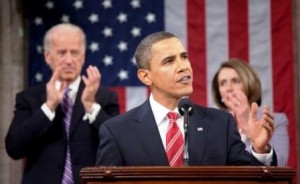
President Obama is expected to announce a compromise on fuel economy standards during a Friday White House news conference.
The contentious debate over the nation’s future fuel economy standards has ended, industry leaders and government regulators reportedly coming up with a compromise that President Obama is expected to announce at the White House on Friday.
The changes, according to inside sources, will provide the industry a bit of breathing room on the light truck side – though not by much. The compromise is expected to call for the industry to meet a target of 56.2 miles per gallon with passenger cars and 54.5 mpg for light trucks by 2025. Currently, automakers are aiming for 35.5 mpg in 2016.
The new rules are expected to call for a two-stage phase-in, with mileage for passenger cars rising 5% annually while light trucks would see fuel economy climb 3.5% a year from 2017 to 2021, then by 5% through 2025.
Administration spokesman Jay Carney confirmed that the changes to the Corporate Average Fuel Economy, or CAFE, standard is expected to save jobs and improve market demand while also reducing oil consumption and pollution.
Word of a compromise comes just days after an automotive lobbying group had planned to launch – but suddenly halted – an aggressive ad campaign designed to criticize the original White House fuel economy proposals. Earlier this year, regulators had been pressing for a 62 mpg target, but that was revised, last month, to 56.2 mpg. The industry had hoped for something closer to 50.
But both sides appear to have decided to avoid the sort of public debate that is now gripping the nation as Washington lawmakers battle over an increase to the federal debt ceiling.
Initial industry reaction has been muted, makers apparently waiting for the White House meeting on Friday. But John Mendel, the senior U.S. executive at American Honda, said the maker, “is proud to have actively worked with the Administration as they developed their proposed national fuel economy and greenhouse gas emissions standards. Honda embraces this challenge, which will be good for our customers and for the environment, and we welcome the competition we will have with other automakers that will result from these new standards.”
Challenge is likely to be the operative word. As one senior Detroit executive, asking for anonymity prior to Friday’s news conference, said, “We really don’t know how we’re going to get there yet.”
Though fuel economy has generally been rising faster than many experts expected in recent years, thanks to technical advances like direct injection and the use of more advanced turbochargers and transmissions – as well as vehicle downsizing – the 2025 target may very well require significant new breakthroughs. Some critics have warned that there will be a large-scale shift to electric propulsion technology. But the reduced light truck target could permit makers to continue offering the heavy-duty pickups and SUVs, maintaining the towing and cargo capacities the American market has traditionally demanded.
Uncertain is the cost of meeting the new 2025 standard. The National Highway Traffic Safety Administration estimated, last fall, that a 5% annual increase in mileage would eventually add $2,100 to the cost of the typical vehicle – which it also said would be offset by fuel savings.
That figure was supported by a recent study by the Boston Consulting Group. But a report by the Michigan-based Center for Automotive Research warned that pushing mileage requirements up towards 60 mpg could add as much as $10,000 to the cost of a vehicle – while reducing annual new car sales by several million as motorists would likely hold onto their older vehicles longer. And that, the CAR study warned, would cost 100s of thousands of U.S. auto jobs.
It remains to be seen if the final CAFE rules will call for a so-called mid-term review to see how the revisions are working – and, if necessary, revise the standards. That proposal has worried some environmentalists who feared the industry might use the opportunity to reduce the planned 2025 targets.
Indeed, it is not yet clear everyone will go along with the White House/industry compromise. California regulators have repeatedly threatened to use their power to set tougher emissions standards to call for a higher mileage requirement. About a quarter of the states now follow California’s stricter tailpipe rules.
Several environmental groups have already dubbed the now-abandoned 56.2 mpg proposal as too much of a compromise. It remains to be seen how they will react to an even lower number for trucks.
But Democratic party leader and enviro-activist Cong. Ed Markey issued a release calling the apparent compromise, “the single greatest step our country has taken to reduce our dependence on foreign oil and to encourage a new generation of advanced vehicle technology entrepreneurs.”
